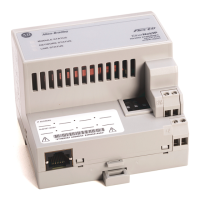Rockwell Automation Publication 1794-UM066C-EN-E - April 2023 9
Chapter 1 Overview of FLEX I/O and Your Redundant EtherNet/IP Adapter
Use of the Control and
Information Protocol (CIP)
The 1794-AENTR and 1794-AENTRXT adapters use the Control and Information Protocol (CIP™). CIP is
the application layer protocol that is specified for EtherNet/IP, the Ethernet Industrial Protocol, as
well as for ControlNet and DeviceNet. It is a message-based protocol that implements a relative
path to send a message from the producing device in a system to the consuming devices.
The producing device contains the path information that steers the message along the proper
route to reach its consumers. Since the producing device holds this information, other devices
along the path simply pass this information; they do not need to store it.
This has two significant benefits:
• You do not need to configure routing tables in the bridging modules, which greatly simplifies
maintenance and module replacement.
• You maintain full control over the route that is taken by each message, which enables you to
select alternative paths for the same end device.
Understand the Producer/
Consumer Model
The CIP Producer/Consumer networking model replaces the old source/destination (master/slave)
model. The Producer/Consumer model reduces network traffic and increases speed of
transmission. In traditional I/O systems, controllers poll input modules to obtain their input status.
In the CIP system input modules are not polled by a controller. Instead, they produce (multicast)
their data either upon a change of state (COS) or periodically. The frequency of update depends
upon the options that are chosen during configuration and where on the network that the input
module resides. The input module, therefore, is a producer of input data and the controller is a
consumer of the data.
The controller can also produce data for other controllers to consume. The produced and
consumed data is accessible by multiple controllers over the EtherNet/IP network. This data
exchange conforms to the Producer/Consumer model.
Specify the Requested
Packet Interval (RPI)
The RPI is the update rate that is specified for a particular piece of data on the network. The RPI
can be specified for the adapter and include all of the I/O modules communicating through it (using
a rack-optimized connection) or specified for a particular module (using direct connection). When
you add a module or an adapter to the I/O configuration of a controller, you must enter the RPI as a
parameter. This value specifies how often to produce the data for that device. For example, if you
specify an RPI of 50 ms, it means that every 50 ms the device should send its data to the controller
or the controller should send its data to the device.
RPIs are only used for devices that produce data. For example, a ControlLogix EtherNet/IP bridge in
the same chassis as the controller does not require an RPI because it is not a data-producing
member of the system; it is used only as a bridge to remote racks.
Rack-optimized and Direct
Connection Support
The 1794-AENTR and 1794-AENTRXT adapters support both direct and rack-optimized connections.
A direct connection is a real-time data transfer link between the controller and the device that the
configuration data references. Direct connection messaging occurs at a cyclic rate that is specified
by the RPI during configuration. A rack-optimized connection is a grouping of data from multiple
I/O module into a single block of data sent over a single connection at the same data rate.
Rack-optimized connections reduce the total number of connections that are needed to transfer
data when using many I/O modules in a system. The following example illustrates the benefit of
rack-optimized connections.
Assume you have set up a system that contains eight discrete I/O modules interfaced to an
adapter. If you use direct connections to transfer data to each of these I/O modules, you need eight
connections to transfer all of the data, one to each of the eight I/O modules. If you use a rack-
optimized connection to transfer the data, you only need a single connection – the connection to
the adapter.

